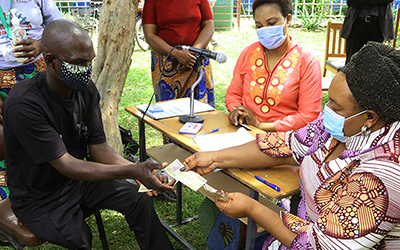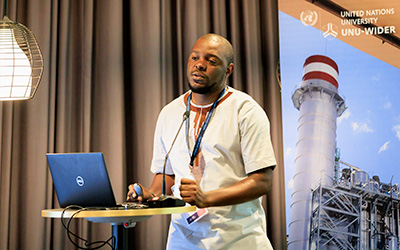Blog
Cash Plus: Towards poverty reduction in Zambia
The Zambian government wants to reduce poverty by 20% by 2030. To make this happen, the government reformed their national cash transfer programmes. But what was the potential impact? In 2021, our MicroZAMOD team conducted an assessment—recommendations of which have been adopted at the highest level.
In 2022, according to the Living Conditions Monitoring Survey (LCMS), Zambia’s poverty level was as high as 60.5%. Poverty and inequality are persistently high in Zambia. In a bid to improve the situation, the Zambian government introduced and progressively expanded the Social Cash Transfer (SCT) programme.
The transfer provides cash payments to the poorest one million households and is intended to be a ‘floor benefit’, with complementary benefits acting as top-ups by further targeting different dimensions of poverty. The Cash Plus programme consists of different cash transfer programmes that look at education, cash grants for businesses, and food security. The vision for ‘Cash Plus’ was to streamline delivery of these different programmes and services in a ‘one stop shop’ setup.
To improve how these programmes jointly help to reduce poverty, the government initiated the Cash Plus reform in 2019. The aim was to take stock of the existing system, its coverage and impact, and provide evidence on the benefits of any potential reforms.
Improving the understanding of the impacts of policy reforms
 This is why in 2021 my organization, the Zambia Institute for Policy Analysis and Research (ZIPAR), joined forces with UNU-WIDER and the Southern African Social Policy Research Insights (SASPRI), to help the government understand the benefits of the Cash Plus reform. To analyse the impact of the programme, we used MicroZAMOD, the tax-benefit microsimulation model for Zambia. MicroZAMOD helps us compare the effects of different benefit policy scenarios on poverty, inequality, and government revenues.
This is why in 2021 my organization, the Zambia Institute for Policy Analysis and Research (ZIPAR), joined forces with UNU-WIDER and the Southern African Social Policy Research Insights (SASPRI), to help the government understand the benefits of the Cash Plus reform. To analyse the impact of the programme, we used MicroZAMOD, the tax-benefit microsimulation model for Zambia. MicroZAMOD helps us compare the effects of different benefit policy scenarios on poverty, inequality, and government revenues.
Apart from modelling, one challenge was to convene the various stakeholders and hold a series of meetings to gather evidence, discuss our approach and intermediate results—not without obstacles and challenges.
One obstacle we encountered involved the initial reluctance of the Zambian Government to allow a single household to benefit from multiple social protection programmes. In our simulations, this turned out to be crucial to support the least affluent households with a meaningful amount overall. Another challenge stemmed from the absence of current and relevant data, hindering our ability to swiftly generate research evidence that could significantly influence policy decisions.
Additionally, a persistent challenge in Zambia has been the establishment of poverty reduction targets without a comprehensive grasp of the required resources to progress toward these goals. Through our policy scenario simulations, we were able to provide the government with estimates of how much each policy reform would cost.
The impact is positive, but…
The results of our assessment provided findings that brought robust knowledge to the debate. The first finding was that the cash transfer system in its current form is positive, as it provides support to 76% of the extremely poor population and reduces poverty by 4 percentage points. But among the extremely poor, only 34% received SCT—the floor benefit.
More notably, even the potential Cash Plus reforms failed to address the main problem. By adding Cash Plus benefits to the social protection system, Zambia was going to reduce poverty. But to achieve Zambia’s ambitious poverty reduction targets, the SCT programme providing the ‘floor benefit’ would need to be expanded too.
In particular, the existing SCT was well-targeted to elderly and rural populations, and those claiming disability, but it rarely reached the extremely poor in urban and/or working-age, male-headed households.
Recommendations adopted at the highest level
My organization was part of a cluster advisory group drafting the 8th National Development Plan, which considered several of our recommendations: linking different cash transfer programmes to allow access to multiple support systems, scaling up the number of beneficiaries and level of support, and strengthening the targeting and payment systems.

Due to our contributions through the Cash Plus initiative, the government has taken steps to enhance the impact of the programme. Initially, following our research and recommendations, the transfer amount was increased from ZMW 110 (USD 4.10) to ZMW 200 ( USD 7.40). Furthermore, our findings highlighted certain groups that were overlooked during the targeting stage, leading to the government's decision to expand the number of beneficiaries to over 1.3 million households.
Notably, the government has extended support to girls in cash transfer households by offering not only free education at the secondary school level, but also providing free education at the tertiary school level, enabling them to choose both the institution and programme of their preference.
These policy changes were adopted at the highest level of government, which is our cabinet, and has now been accepted and adopted as the correct way of implementing our social protection programmes.
In addition to our involvement in Cash Plus, our institution consistently uses MicroZAMOD for our policy initiatives. This tool aids us in analysing and assessing modifications to income tax regimes, conducting national budget analyses, and evaluating the effects of the free education policy. These examples show that our work helps policymakers implement programmes that can improve the lives of people.
Miselo M. Bwalya is a Research Fellow at the Zambia Institute for Policy Analysis and Research (ZIPAR), and a member of the MicroZAMOD national team.
The views expressed in this piece are those of the author(s), and do not necessarily reflect the views of the Institute or the United Nations University, nor the programme/project donors.
 Join the network
Join the network







